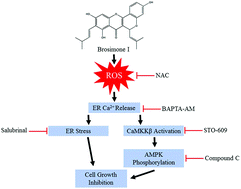Brosimone I, an isoprenoid-substituted flavonoid, induces cell cycle G1 phase arrest and apoptosis through ROS-dependent endoplasmic reticulum stress in HCT116 human colon cancer cells†
Abstract
Brosimone I is an isoprenoid-substituted flavonoid from Artocarpus heterophyllus. Here, we reported for the first time that brosimone I induced cell cycle G1 phase arrest and apoptosis in HCT116 human colon cancer cells. Brosimone I treatment increased the cytosolic Ca2+ level, and subsequently activated the CaMKKβ-AMPK pathway. STO-609, a CaMKKβ inhibitor, and compound C, an AMPK-specific inhibitor, attenuated brosimone I-induced loss of cell viability in HCT116 cells. Furthermore, brosimone I enhanced ER stress. Salubrinal, an ER stress inhibitor, reduced brosimone I-induced cell growth inhibition. In addition, brosimone I was found to increase ROS generation and the inhibition of ROS formation by NAC, a ROS inhibitor, attenuated brosimone I-induced cell death, cytosolic Ca2+ increase, and ER stress markers. Collectively, our findings reveal that brosimone I induces cell cycle G1 phase arrest and apoptosis via the induction of ROS-mediated increased cytosolic Ca2+, ER stress, and the activation of the CaMKKβ-AMPK signaling pathway.



 Please wait while we load your content...
Please wait while we load your content...